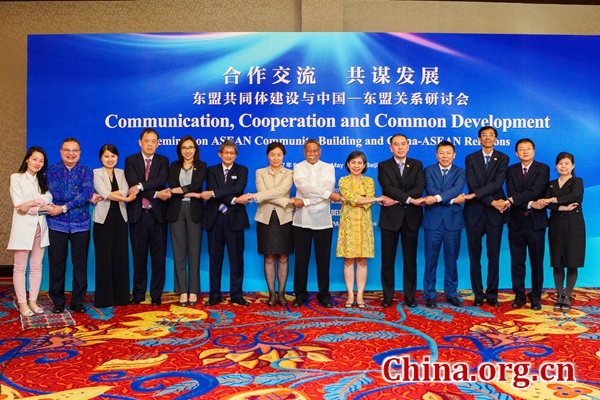China, ASEAN expected to build closer ties
china.org.cn / chinagate.cn, May 17, 2017 Adjust font size:
A one-day forum on China-ASEAN relations organized by Beijing Review, Mission of China to ASEAN and the Pangoal Institution, runs on May 15, in Beijing. [Photo provided to China.org.cn]
Once the combustible center for strife and conflicts, countries allied in the Association of Southeast Asian Nations (ASEAN) are now fostering a path of peace and prosperity under the framework of multilateral cooperation, among which their partnerships with China are much accentuated.
Dr. AKP Mochtan, deputy secretary general of ASEAN, described the relationship between China and ASEAN as a "red string of fate", a Chinese metaphor for the knot tied by married couples.
"This is not a marriage proposal [in the context of bilateral relations. Nevertheless], it is actually what I believe we have shared and how we are connected," he said.
He made his keynote speech when addressing the "Communication, Cooperation and Common Development Seminar on ASEAN Community Building and China-ASEAN Relations", jointly hosted by the weekly magazine Beijing Review, Mission of China to ASEAN and Beijing-based think tank Pangoal Institution.
China and ASEAN are embracing a promising future with good momentum. Trade between China and Southeast Asia reached US$455.44 billion in 2016 and China has been ASEAN's biggest trade partner since 2009. With a mild fluctuation of bilateral trade and investment last year, China and ASEAN are ushering in an era of cultural cooperation and people-to-people exchanges.
In ASEAN, there are 37 cities connected with 52 Chinese cities by means of 5,000 flights. Likewise, about 20 million visitors from China have chosen ASEAN countries as their holiday destinations, an increase of 60.5 percent from two years ago. Meanwhile, the number of ASEAN visitors to China has grown 60 percent to a current 10 million a year.
"I would rather work with a friend in the dark than be alone in the light," Mochtan added.
His remark was echoed by Li Yafang, president of the Beijing Review.
"China and ASEAN are friendly neighbors linked by seas and mountains," Li said, adding that "[ASEAN] countries are the major members of the Belt and Road Initiative (BRI)…and there is an invisible red string of bond [between the two sides] in the jungle."
"China is seeking multilateral cooperation with others, tackling challenges together with ASEAN to achieve common development and prosperity to become a community of common destiny, and contributing to exchanges and cooperation. This is why we are coming today," she said.
This year marked the 50th anniversary of the establishment of ASEAN with an involvement of six countries now grown to 10, namely, Malaysia, Indonesia, Thailand, Philippines, Singapore, Brunei, Vietnam, Laos, Myanmar and Cambodia. It has evolved into a mechanism of "ASEAN plus six" with the additional participation of China, Japan, South Korea, Australia, New Zealand and India, under the framework of the Regional Comprehensive Economic Partnership.
"The 21st Century Maritime Silk Road of the BRI proposed by Chinese President Xi Jinping in 2013 signals a splendid chapter in China's broadened openness," said Yu Hongjun, honorary president of the Academic Committee of the Pangoal Institution and former vice minister of the International Department of the Central Committee of the Communist Party of China (CPC).
"It is being wrongly suggested that an emerging power like China will definitely not escape from the historic pattern of overall rule, which is supposed to lead the country to be a new hegemon in the world," said Yu.
"China's BRI is a peaceful cooperation plan with mutual benefits," he stressed.
According to Yu, there is still room for improvement to achieve even better cooperation. Disturbed by a number of complicated reasons, the trade between China and ASEAN, which has dropped slightly, has, nevertheless, challenged the two sides with targeted trade volume expected to hit US$1 trillion by 2020.
However, despite disputes and differences at times, experts in the forum generally agreed that the cooperation between China and ASEAN should be deepened while tackling technological innovation bringing a potential dramatic transformation of the world.
A fundamental change is taking place by the sweeping dominance of social media that is reshaping the way of mass communication and challenging the loss of readership of the media with traditional contents, said Dato Danny Lee Chian Siong, chairman of the Association for Regional Connectivity.
However, despite such challenges, it has also opened a window for opportunities where Facebook and WeChat can play their roles in boosting the diversity of ASEAN countries, he added.
Wang Xiaohui, editor-in-chief of China.org.cn, said, the relation between China and ASEAN dates back many hundreds of years, so the journalists, who may get the chance to represent the friendship carried on in hearts, languages, lives as well as cultures of the peoples concerned, can tell the stories by using the platform of new media for future information flows on smart phones.
